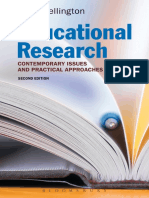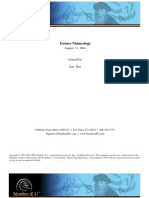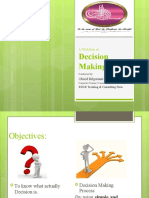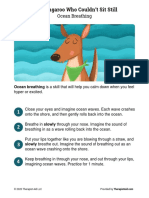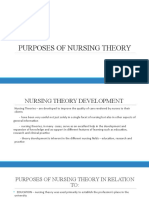4 Qs MBTI
4 Qs MBTI
Uploaded by
rv5Copyright:
Available Formats
4 Qs MBTI
4 Qs MBTI
Uploaded by
rv5Original Description:
Copyright
Available Formats
Share this document
Did you find this document useful?
Is this content inappropriate?
Copyright:
Available Formats
4 Qs MBTI
4 Qs MBTI
Uploaded by
rv5Copyright:
Available Formats
Ref: http://www.personalitypathways.com/type_inventory.
html
Q1. Which is your most natural energy orientation?
Every person has two faces. One is directed towards the OUTER world of activities,
excitements, people, and things. The other is directed inward to the INNER world of
thoughts, interests, ideas, and imagination.
While these are two different but complementary sides of our nature, most people have an
innate preference towards energy from either the OUTER or the INNER world. Thus one of
their faces, either the Extraverted (E) or I ntroverted (I), takes the lead in their personality
development and plays a more dominant role in their behavior.
Extraverted Characteristics
Act first, think/reflect later
Feel deprived when cutoff from
interaction with the outside world
Usually open to and motivated by
outside world of people and things
Enjoy wide variety and change in
people relationships
Introverted Characteristics
Think/reflect first, then Act
Regularly require an amount of
"private time" to recharge batteries
Motivated internally, mind is
sometimes so active it is "closed" to
outside world
Prefer one-to-one communication
and relationships
Choose which best fits:
Extraversion (E) Introversion (I)
Q2. Which way of Perceiving or understanding is most "automatic" or natural?
The Sensing (S) side of our brain notices the sights, sounds, smells and all the sensory
details of the PRESENT. It categorizes, organizes, records and stores the specifics from the
here and now. It is REALITY based, dealing with "what is." It also provides the specific
details of memory & recollections from PAST events.
The Intuitive (N) side of our brain seeks to understand, interpret and form OVERALL
patterns of all the information that is collected and records these patterns and relationships.
It speculates on POSSIBILITIES, including looking into and forecasting the FUTURE. It
is imaginative and conceptual.
While both kinds of perceiving are necessary and used by all people, each of us instinctively
tends to favor one over the other.
Sensing Characteristics
Mentally live in the Now, attending
Intuitive Characteristics
Mentally live in the Future, attending
to present opportunities
Using common sense and creating
practical solutions is automatic-
instinctual
Memory recall is rich in detail of
facts and past events
Best improvise from past experience
Like clear and concrete information;
dislike guessing when facts are
"fuzzy"
to future possibilities
Using imagination and
creating/inventing new possibilities
is automatic-instinctual
Memory recall emphasizes patterns,
contexts, and connections
Best improvise from theoretical
understanding
Comfortable with ambiguous, fuzzy
data and with guessing its meaning.
Choose which best fits:
Sensing (S) iNtuition (N)
Q3. Which way of forming Judgments and making choices is most natural?
The Thinking (T) side of our brain analyzes information in a DETACHED, objective
fashion. It operates from factual principles, deduces and forms conclusions systematically.
It is our logical nature.
The Feeling (F) side of our brain forms conclusions in an ATTACHED and somewhat
global manner, based on likes/dislikes, impact on others, and human and aesthetic values. It
is our subjective nature.
While everyone uses both means of forming conclusions, each person has a natural bias
towards one over the other so that when they give us conflicting directions - one side is the
natural trump card or tiebreaker.
Thinking Characteristics
Instinctively search for facts and
logic in a decision situation.
Naturally notices tasks and work to
be accomplished.
Easily able to provide an objective
and critical analysis.
Accept conflict as a natural, normal
part of relationships with people.
Feeling Characteristics
Instinctively employ personal
feelings and impact on people in
decision situations
Naturally sensitive to people needs
and reactions.
Naturally seek consensus and
popular opinions.
Unsettled by conflict; have almost a
toxic reaction to disharmony.
Choose which best fits:
Thinking (T) Feeling (F)
Q4. What is your "action orientation" towards the outside world?
All people use both judging (thinking and feeling) and perceiving (sensing and intuition)
processes to store information, organize our thoughts, make decisions, take actions and
manage our lives. Yet one of these processes (Judging or Perceiving) tends to take the lead
in our relationship with the outside world . . . while the other governs our inner world.
A Judging (J) style approaches the outside world WITH A PLAN and is oriented towards
organizing one's surroundings, being prepared, making decisions and reaching closure and
completion.
A Perceiving (P) style takes the outside world AS IT COMES and is adopting and
adapting, flexible, open-ended and receptive to new opportunities and changing game plans.
Judging Characteristics
Plan many of the details in advance
before moving into action.
Focus on task-related action;
complete meaningful segments
before moving on.
Work best and avoid stress when
able to keep ahead of deadlines.
Naturally use targets, dates and
standard routines to manage life.
Perceiving Characteristics
Comfortable moving into action
without a plan; plan on-the-go.
Like to multitask, have variety, mix
work and play.
Naturally tolerant of time pressure;
work best close to the deadlines.
Instinctively avoid commitments
which interfere with flexibility,
freedom and variety
Choose which best fits:
Judging (J) Perceiving (P)
Your 4 Personality Type Letters
You might also like
- Life Assessment From Compound EffectDocument4 pagesLife Assessment From Compound Effectsilentweaponsquietwars100% (7)
- Educational Research PDFDocument385 pagesEducational Research PDFShakeel Ahmad100% (5)
- Redesigned Kindergarten Curriculum GuideDocument11 pagesRedesigned Kindergarten Curriculum GuideSchenly Tychingco Tarrobago100% (1)
- Essence of NumerologyDocument20 pagesEssence of NumerologyKishore Thakurdas Khudabadi100% (5)
- Resume WorkshopDocument28 pagesResume Workshopapi-435887629No ratings yet
- Emotional Intelligence - Life SkillsDocument30 pagesEmotional Intelligence - Life Skillskritika_singh887No ratings yet
- Group DynamicsDocument7 pagesGroup Dynamicsranjana30No ratings yet
- Choose Which Best Fits Extraversion (E) Introversion (I) : Q1. Which Is Your Most Natural Energy Orientation?Document3 pagesChoose Which Best Fits Extraversion (E) Introversion (I) : Q1. Which Is Your Most Natural Energy Orientation?natasha_vera100% (1)
- Organizational Behaviour: Notes: 1. Personality Locus of ControlDocument29 pagesOrganizational Behaviour: Notes: 1. Personality Locus of ControlAnmol KaushikNo ratings yet
- The Team: Durgesh Shivalkar Siddhesh Shinde Anasuya Sengupta Swati Narkar Ruksar Sutar Vishal NarvekarDocument27 pagesThe Team: Durgesh Shivalkar Siddhesh Shinde Anasuya Sengupta Swati Narkar Ruksar Sutar Vishal NarvekarToshit jain0% (1)
- AttitudesDocument17 pagesAttitudesVineet SudevNo ratings yet
- Trends Networks and Critical ThinkingDocument16 pagesTrends Networks and Critical ThinkingpedroroxasNo ratings yet
- Ce Laws Report - Bias JudgementDocument16 pagesCe Laws Report - Bias JudgementRomel VinguaNo ratings yet
- 09 Effects On Behavioral Finance On Investment DecisionDocument28 pages09 Effects On Behavioral Finance On Investment DecisionAryo PangestuNo ratings yet
- Group 1 DilemmaDocument31 pagesGroup 1 DilemmaAieree Jim AguilarNo ratings yet
- Topic 4 - Workplace MotivationDocument45 pagesTopic 4 - Workplace MotivationJia Yi SNo ratings yet
- Friend ReportDocument4 pagesFriend ReportDerek BanasNo ratings yet
- Decision Making (Obaid)Document37 pagesDecision Making (Obaid)Anonymous 5F2C52vNo ratings yet
- B B HBDI Questionaire EDocument9 pagesB B HBDI Questionaire EMai-mai PogosaNo ratings yet
- Positive AttitudeDocument11 pagesPositive AttitudebagasndutzNo ratings yet
- ConflictDocument28 pagesConflictKavish BiyaniNo ratings yet
- 22PowerfulToolsToTransformYourFear From ForwardStepsDocument60 pages22PowerfulToolsToTransformYourFear From ForwardStepsHeidi CNo ratings yet
- Problem SolvingDocument22 pagesProblem SolvingArgia WiryawanNo ratings yet
- NSTP Module 3.2Document21 pagesNSTP Module 3.2Lannie GarinNo ratings yet
- The Leadership Compass Activity: Strengthening SolidarityDocument4 pagesThe Leadership Compass Activity: Strengthening SolidaritytonittNo ratings yet
- 02 MotivationDocument25 pages02 MotivationRaj KumarNo ratings yet
- Conflict Resolution Lesson PlanDocument3 pagesConflict Resolution Lesson PlanMistor Dupois WilliamsNo ratings yet
- Jumping Bean ReportDocument4 pagesJumping Bean ReportDerek BanasNo ratings yet
- Mbti-Presentation Phone InterpretationDocument17 pagesMbti-Presentation Phone Interpretationapi-339838665No ratings yet
- Via PosterDocument1 pageVia PosterAdriana GeorgescuNo ratings yet
- Make It Work!: Integrating Virtual Mobility in International Work PlacementsDocument64 pagesMake It Work!: Integrating Virtual Mobility in International Work PlacementsFiorE' BellE'No ratings yet
- Class Reading - Belbin's Team Role TheoryDocument2 pagesClass Reading - Belbin's Team Role TheoryKashaf KhanNo ratings yet
- Conflict Resolution TrainingDocument34 pagesConflict Resolution Trainingcyn2978No ratings yet
- Mechanisms of Self-Control Failure Motivation and Limited ResourcesDocument14 pagesMechanisms of Self-Control Failure Motivation and Limited ResourcesRamona BozianuNo ratings yet
- Critical FinalDocument28 pagesCritical FinalutkarshmohlaNo ratings yet
- Effective CommunicationDocument74 pagesEffective CommunicationAshish SharmaNo ratings yet
- Bahavioral Model - Maelm 214Document45 pagesBahavioral Model - Maelm 214Eda Paje AdornadoNo ratings yet
- The Ultimate EducatorDocument14 pagesThe Ultimate EducatorAlexander Antonio Ortega AlvarezNo ratings yet
- Behavioural Science Powerpoint Presentation 2019-2020Document40 pagesBehavioural Science Powerpoint Presentation 2019-2020Aditya RajNo ratings yet
- PERSONALITYDocument38 pagesPERSONALITYAshraful AlamNo ratings yet
- Listening vs. HearingDocument27 pagesListening vs. HearingSpot LopezNo ratings yet
- What Is Behavioural Communication FinalDocument8 pagesWhat Is Behavioural Communication Finaljitendra7779858100% (1)
- Self Assessment ToolDocument4 pagesSelf Assessment ToolLords PorseenaNo ratings yet
- Seminar On Participative ManagementDocument17 pagesSeminar On Participative Managementvishnu m vNo ratings yet
- Problem Solving Activity WorksheetDocument4 pagesProblem Solving Activity WorksheetAndrea SantoNo ratings yet
- CommunicationDocument66 pagesCommunicationJaganmoy Basu Roy ChowdhuryNo ratings yet
- Topic Management and Organization StructureDocument60 pagesTopic Management and Organization StructureMimi AziraNo ratings yet
- Technique Library PDFDocument328 pagesTechnique Library PDFLuis ArceNo ratings yet
- The Kangaroo Who Couldn't Sit Still: Ocean BreathingDocument3 pagesThe Kangaroo Who Couldn't Sit Still: Ocean BreathingTeri WILSONNo ratings yet
- Chapter 1 ODDocument34 pagesChapter 1 ODRuzzel Cristine AsiloNo ratings yet
- Team Work Is Dream WorkDocument15 pagesTeam Work Is Dream WorkpkNo ratings yet
- Complete Course of Decisions MakingDocument128 pagesComplete Course of Decisions MakingAseel Aseel100% (1)
- 195 TonesDocument3 pages195 TonesSeyed Reza AhlsaadatNo ratings yet
- The Thankful TreeDocument3 pagesThe Thankful Treeapi-227714293No ratings yet
- The Habit 5Document25 pagesThe Habit 5Mohamed OudazNo ratings yet
- The Harmful Effects of Drugs and Alcohol-NDEPDocument4 pagesThe Harmful Effects of Drugs and Alcohol-NDEPFlorie Fe Rosario OrtegaNo ratings yet
- Decision Making For Business and Strategic ChoicesDocument43 pagesDecision Making For Business and Strategic ChoicesAlex AlexNo ratings yet
- 39 PerceptionDocument35 pages39 PerceptionGurleen KaurNo ratings yet
- Leadership Styles Wheel of Balance DBeverlyCoachingDocument2 pagesLeadership Styles Wheel of Balance DBeverlyCoachinghebaNo ratings yet
- When Do You Conduct A Needs Assessment?Document17 pagesWhen Do You Conduct A Needs Assessment?Jesse JhangraNo ratings yet
- Mod 1 1 Concepts of Everyday LeadershipDocument26 pagesMod 1 1 Concepts of Everyday LeadershipSaifuzzaman AntorNo ratings yet
- Nursing and Team BuildingDocument5 pagesNursing and Team BuildingabydlNo ratings yet
- CognitiveBiasesHandout PDFDocument2 pagesCognitiveBiasesHandout PDFCaspiaNo ratings yet
- A-HA! Performance: Building and Managing a Self-Motivated WorkforceFrom EverandA-HA! Performance: Building and Managing a Self-Motivated WorkforceNo ratings yet
- Edison Michael SimanjuntakDocument92 pagesEdison Michael SimanjuntakEdison MichaelNo ratings yet
- 10 Wisconsin Teacher StandardsDocument3 pages10 Wisconsin Teacher Standardsapi-385840602No ratings yet
- Making Inferences LPDocument3 pagesMaking Inferences LPapi-285650257No ratings yet
- DLL EMPOWERING TECHNOLOGIES 3 and 4th WeekDocument16 pagesDLL EMPOWERING TECHNOLOGIES 3 and 4th WeekDolores Mayuga PanchoNo ratings yet
- Sains - Tahun 3Document37 pagesSains - Tahun 3Sekolah Portal100% (11)
- 4 Purposes of Nursing Theory TFNDocument19 pages4 Purposes of Nursing Theory TFNRaiza Madell MaalaNo ratings yet
- Rana Abubakar Khan: Join FB Group For Vu HelpDocument18 pagesRana Abubakar Khan: Join FB Group For Vu HelpUmer FarooqNo ratings yet
- Yarbus (Greene, Liu, Wolfe)Document8 pagesYarbus (Greene, Liu, Wolfe)dekaliberbroNo ratings yet
- A Simple Guide To The Spiritual Meaning of NumbersDocument3 pagesA Simple Guide To The Spiritual Meaning of NumbersLesley-Anne BrewsterNo ratings yet
- Background of The StudyDocument36 pagesBackground of The StudyAnne Paulene Sobretodo100% (1)
- Volume 15 Paper 2 Sundu KaurDocument21 pagesVolume 15 Paper 2 Sundu Kaurbandi2340No ratings yet
- Discourse Analysis and Cultivation of Conversational Competence in English ClassDocument3 pagesDiscourse Analysis and Cultivation of Conversational Competence in English ClassdaitieuthuNo ratings yet
- Year 9 Assessment NotificationDocument1 pageYear 9 Assessment Notificationapi-375416911No ratings yet
- Characteristics of A 21st Century TeachersDocument1 pageCharacteristics of A 21st Century TeachersRenjie Azumi Lexus MillanNo ratings yet
- Chapter 1: What Do Sociolinguists Study?Document3 pagesChapter 1: What Do Sociolinguists Study?Sheng Yuan Soo67% (3)
- Georgias Journey Toward Multiple Criteria Identification of Gifted StudentsDocument4 pagesGeorgias Journey Toward Multiple Criteria Identification of Gifted Studentsapi-301935239No ratings yet
- Unit 1 PsychoDocument33 pagesUnit 1 Psycho21BME031 Sidhant SadyalNo ratings yet
- Montessori DescriptionDocument4 pagesMontessori DescriptionGabrielly De Souza LimaNo ratings yet
- Contoh Individual Report - 360Document20 pagesContoh Individual Report - 360Mamang KendangNo ratings yet
- Pedagogical ApproachesDocument30 pagesPedagogical ApproachesCrizel N. PotanteNo ratings yet
- Factors Influencing Employee Motivation:: A Perception Based Investigation Among The Private Health Service ProvidersDocument8 pagesFactors Influencing Employee Motivation:: A Perception Based Investigation Among The Private Health Service ProvidersRipul NabiNo ratings yet
- Tutorial.5 With AnswersDocument4 pagesTutorial.5 With Answersmenna.abdelshafyNo ratings yet
- Health Teaching Plan School Age: Western Mindanao State University College of Nursing Normal Road, Zamboanga CityDocument7 pagesHealth Teaching Plan School Age: Western Mindanao State University College of Nursing Normal Road, Zamboanga CityJinaan MahmudNo ratings yet
- Analysis of Contemporary Advertising: in Reference To AIDA ModelDocument13 pagesAnalysis of Contemporary Advertising: in Reference To AIDA ModelRoshNo ratings yet
- Some Tips On Better Communications M.Sc. L3Document15 pagesSome Tips On Better Communications M.Sc. L3Dipesh BasnetNo ratings yet
- فاينل اتصالات اداريةDocument153 pagesفاينل اتصالات اداريةmoNo ratings yet

